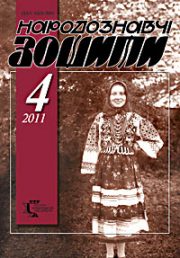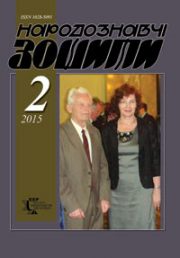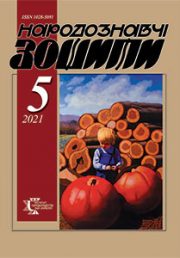The Ethnology Notebooks. 2021. # 2 (158), P. 367—373
УДК 392/393(477):303.1
DOI https://doi.org/10.15407/nz2021.02.367
Oleksandr KUKHARENKO
- ORCID ID: https://orcid.org/0000-0001-5421-1004
- Candidate of Philological Sciences, Associate Professor,
- Associate Professor Kharkiv State Academy of Culture,
- 4, Bursatsky Descent, 61000, Kharkiv, Ukraine,
- e-mail: art-red@ukr.net
FUNERAL AND PUERPERAL RITES: STRUCTURAL AND FUNCTIONAL ANALYSIS
This investigation aims to reconcile the established structures of the cycles of puerperal and funeral rites in accordance with the functions that these structures perform. The object of research is the family rites of the said cycles, and the subject is their structural reflection, which provides an opportunity to accurately explore the sense and functions of traditional rituals.
Method of structural and functional analysis used for the study of traditional national rites opens wide prospects for further scientific research and understanding of the nuances of mythological thinking of our ancestors.
During the coordination of the structure of the funeral cycle, another rite was found in it, tentatively called the death or departure of the soul. In this form, this structure is fully consistent with the structures of the cycles of puerperal and wedding ceremonies, as well as is largely identical to the calendar rites.
The rites of transition in the puerperal cycle are childbirth, naming and baptism; and in the funeral — death struggle, burial in the cemetery and memorial dinner. These rites, called rites of transitions, at the level of mythological thinking are associated with the death and rebirth of the main characters in other statuses. Thus, the unborn becomes the born, the baby, the child, and the dying becomes the dead, the buried, the deceased. Herewith, the unborn and the dying are the initial profane statuses, the born and the dead are the boundary, the baby and the buried are sacred, and the child and the deceased are the final profane statuses.
The cycles of rites themselves, thanks to the created structures, are similar to each other, but are carried out in opposite directions: the action of funeral rites reflects the transition of the deceased from reality to the afterlife, and birth — from the other world to this one.
As a result of research and comparison of the structures of two ritual cycles, a pair of antinomies were established: fertility — death, which after antinomies: reality — afterlife, profane — sacred, is the most important antinomy for the whole cycle of family rites. Since fertility, as the basis and sense of life, is the source of sacralization of otherworldly forces, the only concept that can resist death.
Keywords: Ukrainian ritualism, family rites, maternity rite, funeral rite, structural and functional method.
REFERENCES
- Kukharenko, O. (2018). Structure and Functions of the Maternity Cycle of Rites in the Traditional National Ritualism. Paradigm of Knowledge. Multidisciplinary Scientific Journal, 4 (30), 73—85.
- Kukharenko, O. (2018). Funeral Ceremony in the System of Structural-Functional Studies of Family Objectives. Paradigm of Knowledge. Multidisciplinary Scientific Journal. Muscat, 2, 132—144.
- Kukharenko, O.O. (2016). Research of national rites by means of structure of a wedding cycle. Ukrainian culture: past, present, ways of development, 23, 82—87 [in Ukrainian].
- Eliade, M. (1994). Sacred and secular. Moscow [in Russian].
- Frezer D.D. (1986). The Golden Bough: Researching Magic and Religion. Moscow [in Russian].
- Propp V.Ya. (2000). The historical roots of the fairy tale. Moscow [in Russian].
- Gennep A. van. (1999). Rites of passage. Systematic study of rituals. Moscow [in Russian].
- Voropai, O.I. (1993). Customs of our people: ethnographic essay. Kyiv [in Ukrainian].
- Kylymnyk, S.I. (1961). Ukrainian year in folk customs in historical light (Vol. 3). Winnipeg; Toronto [in Ukrainian].
- Chubynskyj, P.P. (Ed.). (1877). Proceedings of an ethnographic and statistical expedition to the West Russian Territory (Vol. 4) [in Russian].






